-
Posts
14,343 -
Joined
-
Last visited
-
Days Won
25
Content Type
Profiles
Forums
Blogs
Gallery
Events
Store
Posts posted by Ed_Haynes
-
-
I dont understand... I would have figured that he would have been in more trouble for not taking up arms after being encircled. Why would he have been in trouble for becoming a Partisan. Why was he NOT in trouble from ditching his uniform and living the civilian life after being encircled?
There was always the suspicion that those who were encircled (unless wounded to the point of being unconscious, and many even these were not exceptions) had somehow refused to fight and were potential collaborators. Those who fought to the death (as they were expected to) were OK, others were dubious. Even many civilian partisans suffered with the same suspicions.
Given the fact that many Soviets (in the Baltic and the Ukraine, for example) aggressively collaborated . . . .
0 -
........."you had a 50:50 chance".
Ooops-
Thanks,
...story of my life really...

Actually, you see it in wear (in India, where there's no excuse for ignorance) as often wrong as right. Same with the other unbalanced ribbons. A good reason to have all ribbons symmetrical?
0 -
That one is from 2008. I have almost the same one in my 2008 archive.
I thought so. It didn't match the TV coverage of this year's parade.
0 -
Oh, by the way, you have the ribbon reversed. You had a 50:50 chance.
 0
0 -
They are all quite nasty. (And I refer to the quality of manufacture, though I could go beyond that.) So far as I can tell, none are officially made. They are all made up by police for award to themselves. Likewise, there is no formal notification of new clasps and no one (quite literally) has any a clue what clasps exist; there seem to be at least sixteen (Haynes & Chhina, pp. 118-20). I suspect local police just concoct new clasps so they can have more medals. Yet, the names of all recipients of this unnamed medal have to be published in the Gazette of India. Go figure.

In addition, there are no multi-clasp medals. If you get it for Punjab, you wear the Punjab medal. If you then get it for Jammu and Kashmir, you add that medal. If you get it again for Punjab, you add a third medal. See the attached ribbon bar (not a good scan, sorry).

We believe the same approach will be taken for the unfortunately named "Police Antrik Suraksha Seva Padak" or "Police Internal Security Medal". It is (understandalbly) widely known by its Hindi abbreviation as the "Police ASS Medal".
 0
0 -
Anyway, what was the Indian Title Badge awarded for? Was this a high level service award?
For a skeletal introduction, see http://gmic.co.uk/index.php?showtopic=2854
Some were awarded as "retirement gifts" for long and good service, some were awarded for what equated to gallantry, and some were awarded to Indian collabarators with the British (the popular image of these titles at the time). They were awarded under a wide range of circumstances. And many were returned or refused beginning in the 1930s as a symbolic rejection of British legitimacy. (Higher awards has been returned earlier.) They are fascinating awards!
I am in the process of finishing a long article on them, though not sure where to submit it.
They are very poorly understood, perhaps because they were not awarded to Europeans (or even Anglo-Indians).
0 -
You want more? Try Youtube, search on " World War 2 - Victory Day 2009 [PART" and get soem nice eye-candy and a Russian lesson all at once.
0 -
One more (ignore the guys in the front row).
 0
0 -
-
-
Ignore the guy speaking, show me the guys behind him!
 0
0 -
Fantastic!!
Why was the Independence ribbon shorter?
It was issued that way. Most recipients had no other medals.
The penny drops- AN UNNAMED WAR MEDAL!!??? was this standard? I have never heard of such a thing.They do show up occasionally for States' Forces, but I wonder if this was self-awarded. Police wouldn't have gotten it in any case. Same for WWII where lack of naming also a red flag.
Are you looking for replacement ribbons at all?Thanks, but have them, Just need to dress the medals and re-scan. Many groups need that attention.
0 -
Mongolia certainly has its own police. Has had them since the 1920s. Some rather nicer than your average police person.
There is a lot of writing out there about Chengis Khan, much of it utter rubbish. (Actually, the recent film isn't bad, though all "Inner" Moingolians and Buriats.)
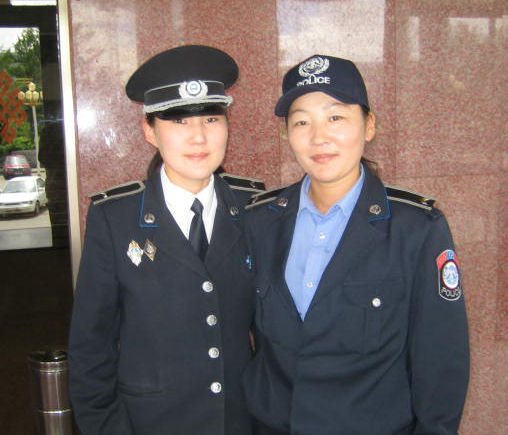 0
0 -
Rai Bahadur Bhupendra Nath Banarji, Deputy Commissioner of Police, South District, Calcutta, Bengal
Indian Title Badge, Rai Bahadur, George V
Rai Sahib Bhupendra Nath Banarji, Deputy Commissioner of Police, South District, Calcutta, Bengal
Not. No. 316-H of 3 June 1931; Foreign & Political, 94-H/1931
"Rai Sahib B. N. Banarji is an Imperial Police Officer having been promoted to that rank in 1926, and having acted as Deputy Commissioner of Police, Calcutta, since 1924. For the last six years he has held charge of the South District and throughout the period of his administration has been characterised by initiative and thoroughness. He did exceptionally well in the communal troubles in Calcutta in 1926 and has handled the civil disobedience movement in his district with firmness and success. [!] He has throughout his career proved himself a loyal, industrious, and successful police officer. He received his present title in 1927 and has justified his advancement to the higher title for which he is now recommended.
Indian Title Badge, Rai Sahib, George V
Babu Bhupendra Nath Banarji, Assistant Commissioner of Police, Calcutta, Bengal
Not. No. 21-H of 1 January 1927; Foreign & Political, 71(2)-H/1926
"Babu Bhupendra Nath Banarji joined the Bengal Police in 1905 and secured promotion to the rank of inspector in 1914 and Assistant Commissioner in 1919. Since 1914, when his services were transferred tro the Calcutta Police, his work has been exceptionally good, and has been distinguished by unusual ability, energy, integrity, efficiency and reliability. Whilst holding charge of Calcutta during the communal riots of 1926, during the first phase of which he was seriously injured in the performance of his duty, he displayed great presence of mind, courage, and perserverance. These qualities and the excellent work done by him at every stage of his career render him worthy of the distinction recommended."
George V Jubilee, 1935
On roll (p. 58, sl. 459) as "Banarji, Bhupendra Nath - Rai Bahadur - Indian Police, Deputy Commissioner of Police, Calcutta".
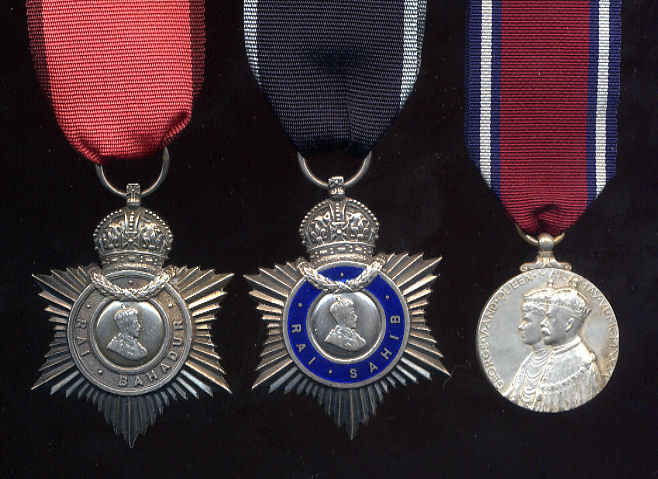 0
0 -
Interesting to have the Independence Medal. Ed, do you source these in India or, UK - a fine collection, just for these Indian ones and they all seem to be for high ranks.
Most of my collection comes from India, but a few (including this one) are from a major UK-dwelling collection that is being dispersed.
Low-rankers rarely got/get medals, while those of high rank were/are aggressive in awarding things to themselves. Indeed, pre-1947, Indians in the police rarely got medals.
0 -
Yes. And the events in Bardoli District that are mentioned in his Khan Sahib recommendation were led by a terrorist (to the British) named Mohandas Karamchand Gandhi.
0 -
Rai Sahib is one of the lowest level (3rd class) of Indian Titles Badges, awarded 1911-46. See http://gmic.co.uk/index.php?showtopic=2854 for a rough outline of these fascinating things.
0 -
Rai Sahib Radha Raman Chatarji, Inspector of Police, Intelligence Branch, Bengal Police
Still needs a good bit of research, but the likely nature of his work may make this difficult.
Indian Title Badge, George VI, 3rd class, Rai Sahib
Babu Radha Raman Chatarji 14th June 1945
Not. No. 136-H of 14 June 1945: ?Babu Radha Raman Chatarji, Special Superintendent of Police, Intelligence Branch, Bengal?. Getting the recommendation is item #1 for the next research trip to Delhi.
King?s Police Medal, George V, 2nd type
RADHA RAMAN CHATARJI, INSPECTOR, BENGAL POLICE
London Gazette, 1 January 1936, as ?Inspector, Bengal Police?.
George V Jubilee
On roll, p. 119, as ?Inspector of Police, Intelligence Branch, Bengal?.
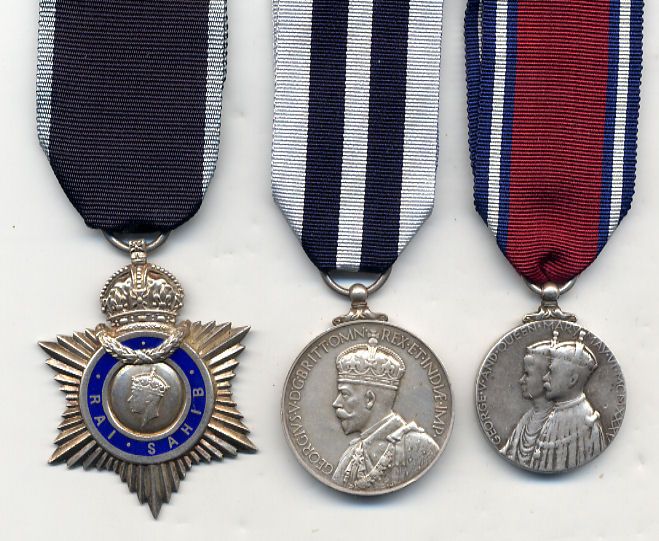 0
0 -
Rai Sahib Ganesh Dass, Inspector of Police, Quetta City, Baluchistan
Indian Title Badge, George V, first variety, 3rd class, Rai Sahib
Lala Ganesh Dass
An undated retrospective award of 1911 for those receiving titles prior to the institution of Title Badges. Title awarded in 1907 to Lala Ganesh Dass, Inspector of Police, Baluchistan.
Not. No. 10-I.C. of 1 January 1907: ?Lala Ganesh Dass, Inspector of Police, Quetta City.?
Foreign Department, Frontier B, March 1907, 24-27:
?This officer is shortly to retire after 33 years? service of which over 20 have been in Baluchistan. After many years? approved service in the Quetta-Pishin district, he was specially selected by the Political Agent for work in Zhob in the early and difficult days of that Agency. When leaving the Agency Major McIvor noted, ?He has fully answered my expectations which were high. I have read over all his certificates and, good as they are, I think they are not one bit too good. . . . Ganeshdass has shown the greatest zeal and intrepidity in pursuing thieves right to the Kundar with next to no escort. He continued to do excellent work in Zhob for a number of years, his influence with the Pathans making him of the greatest use to successive district officers. Since his return to Quetta, his work has been equally valuable.?
?Major Archer, in again recommending this officer in March 1906, wrote:--
??He has continued to do most valuable work, and he has recently rendered excellent service in connection with the Royal visit. The anxieties connected with that visit would have been very much greater if we had not had Ganeshdas in charge of the City.?
?Mr. Tucker, Officiating Agent to the Governor-General in Baluchistan has noted as follows:--
??I endorse these remarks and shall welcome the grant of this title of honour.??
King's Police Medal, George V, 1st type
RAI SAHIB GANESH DASS. INSPECTOR CITY POLICE, QUETTA (BALUCHISTAN)
Gazette of India 16 December 1911, Rai Sahib Ganesh Dass, Inspector City Police (Baluchistan).
Visit of the Prince of Wales, 1905
Recorded in the Royal Archives at Windsor under the name ?Ganesh Dass, Native Inspector, Quetta Police.? Only 70 medals presented. Ribbon incorrect.
Delhi Durbar 1911, silver
Unnamed. Civil rolls elusive.
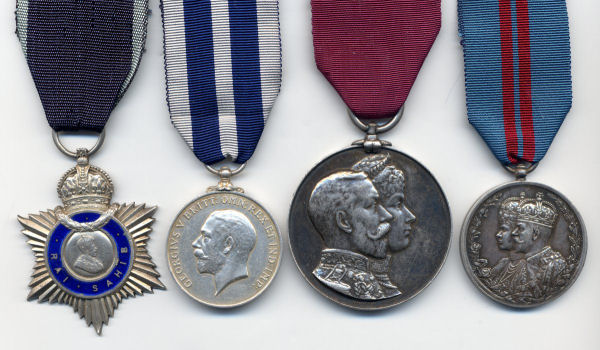 0
0 -
Khan Bahadur Nasarvanji Navraoji Sadri, K.P.M., Inspector-General of Police, Kolhapur State
While this had been posted over in the old "British" sub-forum (where it engendered almost zero interest, even with the Masonic "crossover"), I thought it would be worth cross-linking it here: http://gmic.co.uk/index.php?showtopic=2324
0 -
The group also came with two of his ribbon bars.
 0
0 -
Bakshi Badri Nath, I.P.S., Assistant Dir. S.I.B., Amritsar
Still much research needed and some of the medals are naked, but still an interesting group. There may be some self-awarding of the two war medals here?
President's Police and Fire Services Medal for Distinguished Service
Bakshi Badri Nath, I.P.S., Assistant Dir. S.I.B., Amritsar
Independence Medal 1950
Original mounting.
King's Police Medal for Distinguished Service
RAI BAHADUR BADRI NATH SUPDT. OF POLICE, C.I.D. (OFFG.), PUNJAB
London Gazette, 1 January 1948, one of those rare post-Independence "Dominion"awards of the KPM (and, note, it is still the "INDIAE IMP" variety even though those weren't the king's titles then!)
Indian Title Badge, Rai Bahadur, George VI
Mr. Bakshi Badri Nath, 1st Jany. 1942
The recommendation remains elusive suggesting it was a politically "loaded" one. (And he wears this out of order, after the KPM, so I keep it there.)
George VI Coronation Medal
British War Medal
Unnamed
War Medal 1939-45
 0
0 -
Deputy Inspector General Mohamed Quadir Ali, I.P.S., Mysore
President's Police and Fire Services Medal for Distinguished Service
M. Quadir Ali, I.P.S., D.I.G. Mysore
Not. No. 3-Pres./66 of 26 January 1966 (Gazette of India, 5 February 1966, p. 75):
"Shri Mohmed Quadir Ali, I.P.S.
"Deputy Inspector General of Police
"Central Range
"Bangalore, Mysore"
Police Medal for Meritorious Service, 1st variety
M. Quadir Ali, I.P.S., D.I.G. Police, Mysore
Notficaton No. 5-Pres./59 of 26 January 1959 (Gazette of India, 31 January 1959, p. 52):
"Shri Mohamed Quadir Ali, .I.P.S., Deputy Inspector General of Polce, Southern Range, Mysore."
Independence Medal, 1950
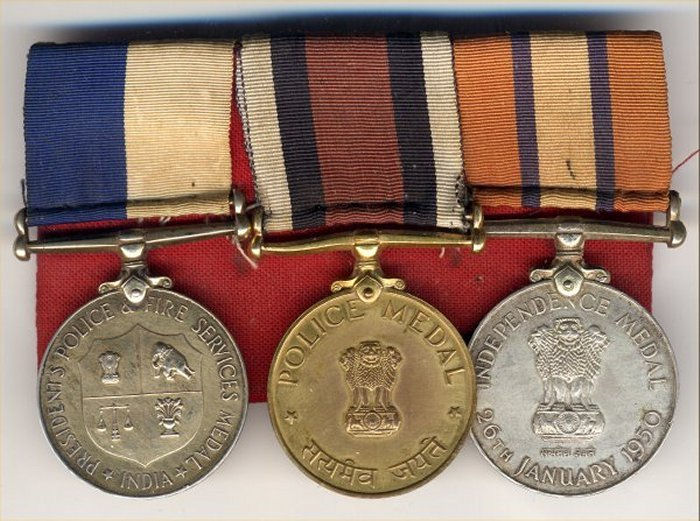 0
0 -
I never intended to build a collection of medals to the Indian Police, never really wanted them. But the universe had other plans for me, and a number of nice Indian police medal groups have come my way. I'll be posting several here.
Deputy Superintendent (Officiating) Khyatendra Pal Singh Singh, Uttar Pradesh Police
While the previous custodian did a very poor mounting job, it is still a nice group.
Police Medal for Gallantry
K. P. Singh, Dy. S.P. (Offg.), U.P.
Not. No. 61-Pres./60 of 11 October 1960 (GoI 15 October 1960, p. 232):
"Shri Khyatendra Pal Singh, Deputy Superintendent of Police (Officiating), Agra, Uttar Pradesh.
"On receipt of information at about 13:00 hours on the 21st March 1960, that the gang of the notorious dacoit Balwanta, who was wanted in several cases of dacoity, murder and kidnapping in Uttar Pradesh was in the ravines of River Utangan near villages Behari and Chamarpura, Shri Khyatendra Pal Singh, Circle Officer, Fatehabad, District Agra, accompanied by the Station Officer of Police Station Fatehabad and the available force, including P.A.C., immediately proceeded to the ravines. The force was divided into four parties. Two of the parties lay in ambush on the likely routes of escape of the gang and the other two parties, one under the command of Sri Khyatendra Pal Singh himself, proceeded to close in from two sides and strike at the gang. At about 16:45 hours the dacoits noticed the police force advancing towards them and immediately opened fire on the party led by Sri Khyatendra Pal Singh. Undaunted by the firing and unmindful of his personal safety he continued his advance toward the dacoits. Balwanta, the leader of the gang, who had taken up a commanding position, continued to fire wildly at the police party. Sri Khyatendra Pal Singh at great personal risk came up close to the dacoits and succeeded in shooting down Balwanta. The rest of the gang managed to escape through the ravines. One DBBL 12 bore gun with a large quantity of ammunition was found with Balwanta.
"In the brief and successful encounter Sri Khyatendra Pal Singh exhibited exemplary courage, leadership and devotion to duty at great personal risk."
Police (Special Duty) Medal - JAMMU & KASHMIR
Unnamed as usual. Ribbon mounted reversed
Independence Medal, 1950
Unnamed as usual. Mounted with the medal reversed and on the wrong ribbon (QSA).
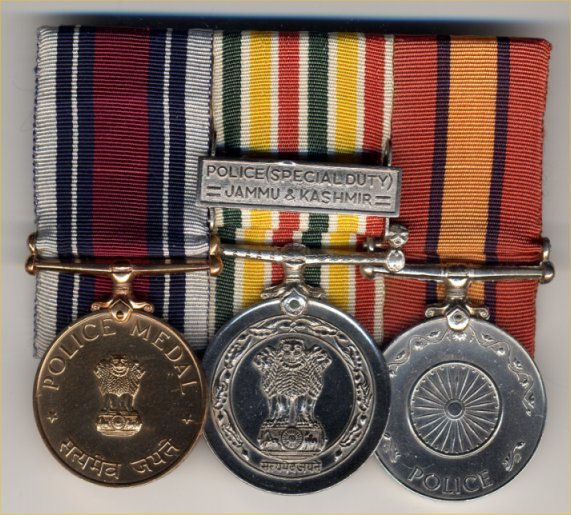 0
0






RAREST POLICE ITEM - START OF I.R.A.
in Great Britain: Mervyn Mitton's British & Colonial Police Forces
Posted
Wow! Most impressive and historical item!